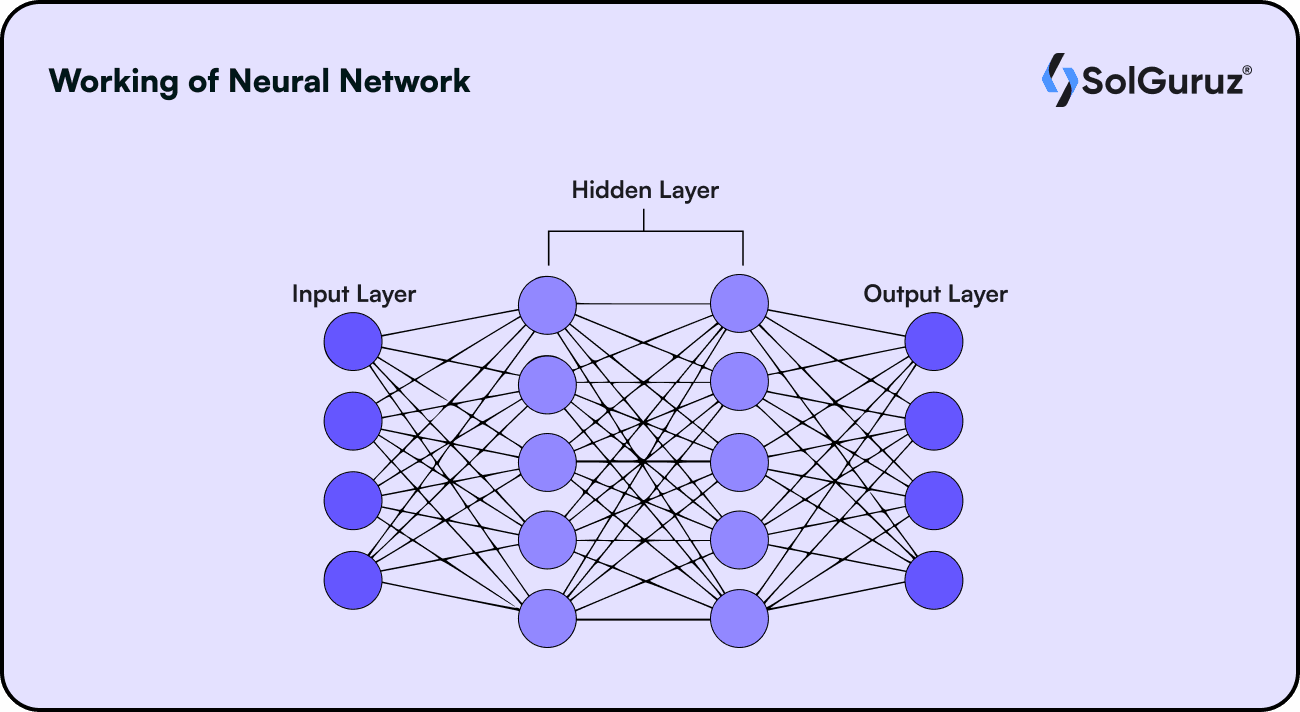A neural network is the basic building block of any artificial or generative AI model. Layers of connected neurons make up neural networks, and these networks learn by varying the weights of the connections among the neurons. To put it simply, it is computer systems mimicking the human brain.
Why Neural Networks?
Since we want the machines to behave like humans, we would want the machines to have a part similar like human brain. Human brain has neural cells which communicate with each other to give messages to the hypothalamus.
Similarly, to imitate the human like communication neural networks are formed artificially. Neural networks are also trained with data to behave like human brain.
Google Search Algorithm is one of the most used neural networks.
It is like wherever AI is present, neural networks are present.
Working of Neural Network
An array of nodes makes up a neural network. There are at least three layers in which the nodes are dispersed.
There are three layers:
- Input Layer
- Hidden Layer
- Output Layer

These three layers are the bare minimum. A neural network can have multiple hidden layers in addition to the input and output layers.
Each node, regardless of the layer it belongs to, processes the input it receives from the preceding node (or from the input layer) in some way. In essence, every node has a mathematical formula with distinct weights assigned to each of its variables.
The node moves data to the next if the result of using that mathematical formula on the input is greater than a predetermined threshold. If the output is below the threshold, then no data will be transmitted to the next layer.
Types of Neural Networks
There are neural network classifications on -
- Classified on Depth
- General classification
1. Classified on Depth
- Shallow - These neural networks usually have one hidden layer
- Deep - These neural networks have more than one hidden layer.
2. General Classification
1. Artificial Neural Networks (ANNs): are neural networks with several hidden layers. Standard artificial neural networks are composed of multiple interconnected processing nodes, or neurons, that exchange information with one another via synapses. Each neuron, or node, in a typical neural network takes input from a number of other neurons and generates an output that is then transmitted to other neurons in the network.
2. CNNs, or convolutional neural networks: are a particular kind of neural network that work well for tasks involving the classification of images. CNNs operate by applying a number of filters to an image that is intended to identify one or more particular characteristics.
3. Recurrent neural network (RNN): RNNs are a type of deep neural network that can perform sequential processing on data by storing and forwarding information from earlier calculations. A particular kind of neural network in which the fresh input and the output from the previous timestep are used as input for the current timestep.
4. Long short-term memory, or LSTM: is a type of deep neural network that has the capacity to store data for extended periods of time. As a result, it can gain knowledge from encounters spanning numerous time steps. An artificial neural network type called LSTM is utilized to analyze sequential data.
5. Multi-Layer Perceptrons: Perceptrons are stacked in linked layers to form a multi-layered perceptron (MLP). The input layer gathers patterns entered. The output layer may use input patterns to map to output signals or classifications.
6. Feed-Forward Neural Networks: One of the more basic varieties of neural networks is feed-forward neural networks. Through the input nodes, information is transmitted in a single path, where it is processed until it reaches the output mode. The most common application for feed-forward neural networks is in facial recognition technology. These networks may contain hidden layers for functionality.
Use Cases of Neural Networks
One of the most known uses is generative AI. Generative AI models implement neural networks as their base models. Other applications are -
1) Image Classification
Real world image classification like classifying images with humans, or objects. The various applications may include X-Ray, CT-scan, MRI, image tagging or surveillance.
2) Weather Prediction
Using RNNs to predict the weather. A time-series based data is used so CNNs or RNNs can be used.
3) Speech Recognition
Deep learning models like neural networks are used in speech recognition. The input data can be audio or video, and the output can be a text transcript.
4) Face Recognition
Deep-learning neural networks have become a viable option for face recognition. When compared to previous machine learning algorithms and methodologies, deep neural network models have significantly improved accuracy levels and provide a workable solution for the picture categorization problem.
5) Self-Driving Cars
To create a variety of models that can be utilized for autonomous driving, a custom neural network architecture made up of CNN, ANN, etc., would be needed.
Wrapping up
From having an idea of “a thinking machine” to “generative AI” and AI making decisions , and recognitions. With so much progress made, the future of neural networks is bright. With more advancements and newer innovations, the application of neural networks will become more apt and widespread.
Looking for an AI Development Partner?
SolGuruz helps you build reliable, production-ready AI solutions - from LLM apps and AI agents to end-to-end AI product development.

Strict NDA

Trusted by Startups & Enterprises Worldwide

Flexible Engagement Models

1 Week Risk-Free Trial
Give us a call now!

+1 (724) 577-7737
Next-Gen AI Development Services
As a leading AI development agency, we build intelligent, scalable solutions - from LLM apps to AI agents and automation workflows. Our AI development services help modern businesses upgrade their products, streamline operations, and launch powerful AI-driven experiences faster.
Why SolGuruz Is the #1 AI Development Company?
Most teams can build AI features. We build AI that moves your business forward.
As a trusted AI development agency, we don’t just offer AI software development services. We combine strategy, engineering, and product thinking to deliver solutions that are practical, scalable, and aligned with real business outcomes - not just hype.
Why Global Brands Choose SolGuruz as Their AI Development Company:
Business - First Approach
We always begin by understanding what you're really trying to achieve, like automating any mundane task, improving decision-making processes, or personalizing user experiences. Whatever it is, we will make sure to build an AI solution that strictly meets your business goals and not just any latest technology.
Custom AI Development (No Templates, No Generic Models)
Every business is unique, and so is its workflow, data, and challenges. That's why we don't believe in using templates or ready-made models. Instead, what we do is design your AI solution from scratch, specifically for your needs, so that you get exactly what works for your business.
Fast Delivery With Proven Engineering Processes
We know your time matters. That's why we follow a solid, well-tested delivery process. Our developers move fast and stay flexible to make changes. Moreover, we always keep you posted at every step of the AI software development process.
Senior AI Engineers & Product Experts
When you work with us, you're teaming up with experienced AI engineers, data scientists, and designers who've delivered real results across industries. And they are not just technically strong but actually know how to turn complex ideas into working products that are clean, efficient, and user-friendly.
Transparent, Reliable, and Easy Collaboration
From day one, we keep clear expectations on timelines, take feedback positively, and share regular check-ins. So that you'll always know how we are progressing and how it's going.
Have an AI idea? Let’s build your next-gen digital solution together.
Whether you’re modernizing a legacy system or launching a new AI-powered product, our AI engineers and product team help you design, develop, and deploy solutions that deliver real business value.










